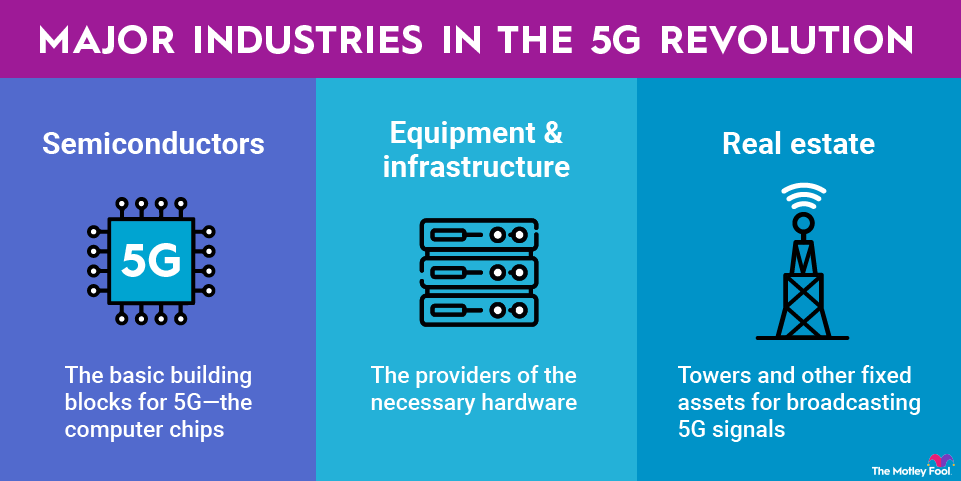The communications sector is broadly defined these days, encompassing everything from century-old legacy media companies to internet stocks. A communication services stock is a share in a company that facilitates the distribution of information and entertainment on a one-to-many or one-to-one basis.

Information technology companies use computers and software to help businesses and individuals stay connected. Telecommunications companies provide the infrastructure and services for distributing information. Television broadcast networks, broadband internet, and mobile wireless networks are also parts of the communications sector.
As we grow increasingly connected (and physically apart), the ability to send and receive information over distances becomes increasingly important. The communications sector will continue to produce important and valuable companies.
Best communications stocks in 2025
Here are five of the better stocks that are communicating with investors.
| Name and ticker | Market cap | Dividend yield | Industry |
|---|---|---|---|
| T-Mobile US (NASDAQ:TMUS) | $231.5 billion | 1.70% | Wireless Telecommunication Services |
| Comcast (NASDAQ:CMCSA) | $99.7 billion | 4.75% | Media |
| Netflix (NASDAQ:NFLX) | $467.7 billion | 0.00% | Entertainment |
| Alphabet (NASDAQ:GOOG) | $3.4 trillion | 0.29% | Interactive Media and Services |
| Meta Platforms (NASDAQ:META) | $1.6 trillion | 0.33% | Interactive Media and Services |
1. T-Mobile

NASDAQ: TMUS
Key Data Points
T-Mobile (TMUS -0.59%) is a leading wireless phone and internet service provider in the U.S. The company found itself in an advantageous position following its acquisition of Sprint in 2020, which provided it with valuable midband radio spectrum.
The carrier has deployed that spectrum quickly, building out the biggest 5G network in the U.S., and its coverage is well ahead of that of its biggest competitors. Going forward, T-Mobile should be able to attract customers based on the strength of its brand and service instead of relying on heavy promotions as it did in the previous decade. That's seen in recent financial results, where average revenue per user increased substantially from earlier in the decade.
T-Mobile also offers home internet service in markets where its mobile network capacity exceeds demand. As part of its merger with Sprint, it committed to covering 90% of rural households with home internet over 5G. That’s a sizable opportunity for the company since most rural areas have limited options for broadband internet. It’s also having success luring urban and suburban customers away from cable internet service.
2. Comcast

NASDAQ: CMCSA
Key Data Points
Comcast (CMCSA -0.84%) is the largest cable television and internet service provider in the U.S. While its subscriber base is shrinking for both video and broadband internet, steady price increases and low costs make it very profitable. Its cable network is easy to maintain, and it can upgrade service with low incremental costs.
In 2018, the company acquired a majority stake in Sky, a leading pay TV operator in the U.K. and other European countries. It also operates a media company that produces sports, news, and entertainment television for its European audience.
Comcast’s NBCUniversal is one of the biggest media companies in the world. It includes global film and television productions, as well as a broad portfolio of U.S. cable and broadcast television networks. NBCUniversal also operates Peacock, a streaming service that gives it exposure to the direct-to-consumer media market.
Comcast plans to spin off NBCUniversal's cable TV networks, but retain the film and television studios, broadcast networks, theme parks, and streaming service.
Comcast is building a wireless phone business to offset losses in the cable business. So far, it's seen good traction by bundling subscribers, and now counts more than 8.5 million subscribers.
3. Netflix

NASDAQ: NFLX
Key Data Points
4. Alphabet
5. Meta Platforms

NASDAQ: META
Key Data Points
Why invest in communication services stocks?
The need for communication companies is only growing as we become increasingly distanced. Not only are we more mobile than ever with the ability to quickly move from city to city around the world, but trends like remote work also rely heavily on communication capabilities for enterprises.
The sector is incredibly diverse. It ranges from growth stocks with the potential for market-beating returns to value stocks paying lofty dividend yields. There's something for almost any type of investor. The key, however, is making sure you buy companies with strong competitive advantages that they can maintain for the foreseeable future. As communication needs continue to expand, those companies are the ones that stand to benefit.
How to analyze communications stocks
The communications sector is broad and encompasses many different fields. It’s generally best to compare communications companies that mainly operate in the same industries or that are at similar stages of growth.
- Compare a company's user base to its competitors. Is it larger or growing faster?
- Use revenue per user to compare similar businesses as a signal of competitive moats.
- Dividend yield is an important factor to consider for many communications stocks.
- Investors should also pay attention to cash flow.
Each industry within communications has an area of spending that should produce significant returns over time.
- Telecommunications companies should produce strong returns on their capital expenditures.
- Information technology companies should produce strong returns on their research and development (R&D) spending.
- Media companies should produce strong returns on their content expenses.
Related investing topics
The communications sector is poised to grow
The amount of data moving over long distances is growing every year. Whether it’s a simple text message on a mobile device, a film streamed over the internet, or important classified business communications, internet connectivity and 5G networks will only increase in importance, along with platforms that deliver information. Buying strong companies across the communications sector should produce good returns for investors as this trend continues.





